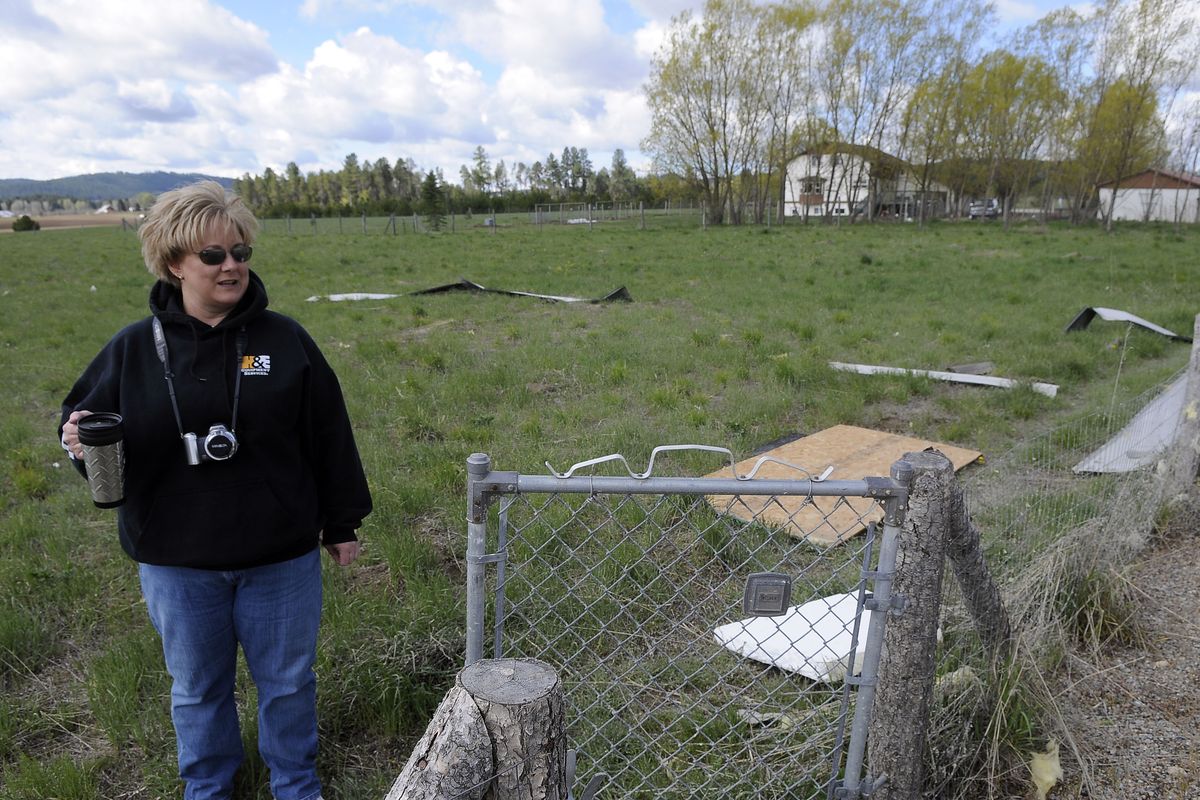High winds wreak damage on prairie
Meteorologist says thunderstorm caused fast-moving ‘downburst’ north of Spokane

Lynn White and her family hunkered down in their Wild Rose Prairie home north of Spokane on Wednesday night while high winds from a thunderstorm slammed their home in what a meteorologist said was a quick-moving “downburst.”
“It was kind of an eerie, howling sound,” White said Thursday.
Her daughter, Risa White, said, “We watched planks flying by the window.”
The high winds lasted less than a minute, allowing the Whites to go outside in the dark to assess the damage.
The storm uprooted small trees and slammed one into the rear of a family van; shoved a 2,600-pound equipment trailer into a Toyota Camry, damaging the vehicle’s front end; and ripped open the metal roof of a 40- by 60-foot shop and garage and creased its 16-foot bay door.
Trusses at one end of the shop roof were snapped.
“The metal blew past the end of our property,” White said. “It was a lot of debris flying around.”
The home about 25 feet from the shop was not damaged, although scaffolding placed along the house for home improvement work was scattered by the wind, sending its planks flying past the windows, she said.
Debris, including large chunks of metal roofing and torn strand-board, were tossed nearly 300 yards downwind.
Rear windows on two east-facing vehicles were broken out, apparently by objects striking them.
“I’m glad we were all inside. Somebody could have gotten hurt,” said Randy White, who operates a general construction business from his residence.
Funnel clouds had been spotted earlier in the evening in Lincoln County from a line of heavy storms moving from southwest to northeast toward the Whites’ home.
The heaviest weather passed to the north of the Spokane urban area, according to the National Weather Service.
Meteorologist Greg Koch surveyed the damage at the Whites’ home at midday and estimated that the wind was blowing at least 80 mph.
He then drove a grid of roads to survey the surrounding area.
Koch said it appeared that a downburst from the thunderstorm blew across a relatively narrow, six-mile path running west to east from the Stevens County line to South Dragoon Drive at U.S. Highway 395. A dozen trees were torn up near the highway, Koch said.
A second home 1 mile to the west of the Whites’ property also had damage. Shingles were ripped off the roof and a shed was crumpled, he said.
Winds at that location were at least 70 mph, Koch said.
Although the damage was severe, weather service meteorologists said they did not believe that a tornado had touched down at the Whites’ home.
Koch said he found no evidence of swirling or twisting in the damage or debris that would indicate a tornado.
Jeremy Wolf, a forecaster at the weather service, said the damage apparently came from the strong outflow of cold air that often descends from vertically towering thunderstorms.
Outflow winds, accelerated by the cooling effect of heavy rain, hit the ground and rushed out in a single direction.
The pattern is often referred to as a “straight-line wind” to distinguish it from the rotation in a tornado.
Straight-line winds occur frequently with thunderstorms in Eastern Washington.
When confined to areas of less than 2 1/2 miles, they are known as “microbursts.”
Wolf said that radar images during the storm did not show the kind of rotation pattern that can be expected during a tornado.
However, rotation was evident earlier in the evening when the funnel clouds were spotted over Lincoln County.
This week is Severe Weather Awareness Week for the weather service, which has been warning the public about the dangers of thunderstorms, lightning, wind, hail, tornadoes, floods and wintry conditions throughout the week.
Washington averages one to two tornadoes a year.